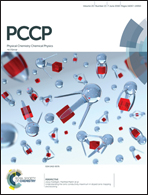Plasmonically enhanced electromotive force of narrow bandgap PbS QD-based photovoltaics†
Abstract
Electromotive force of photovoltaics is a key to define the output power density of photovoltaics. Multiple exciton generation (MEG) exhibited by semiconductor quantum dots (QDs) has great potential to enhance photovoltaic performance owing to the ability to generate more than one electron–hole pairs when absorbing a single photon. However, even in MEG-based photovoltaics, limitation of modifying the electromotive force exists due to the intrinsic electrochemical potential of the conduction band-edges of QDs. Here we report a pronouncedly improved photovoltaic performance by constructing a PbS QD-sensitized electrode that comprises plasmon-active Au nanoparticles embedded in a titanium dioxide thin film. Significant enhancement on electromotive force is characterized by the onset potential of photocurrent generation using MEG-effective PbS QDs with a narrow bandgap energy (Eg = 0.9 eV). By coupling with localized surface plasmon resonance (LSPR), such QDs exhibit improved photoresponses and the highest output power density over the other QDs with larger bandgap energies (Eg = 1.1 and 1.7 eV) under visible light irradiation. The wavelength-dependent onset potential and the output power density suggest effective electron injection owing to the enhanced density of electrons excited by energy overlapping between MEG and LSPR.



 Please wait while we load your content...
Please wait while we load your content...